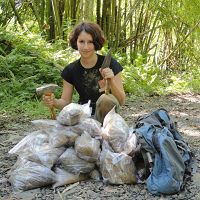ESA relationships between microbial ecology and SOM
Exploring relationships between microbial ecology and soil organic matter stability in deep tropical soil profiles
328, Baltimore Convention Center
-
Christina, Luquillo, INVESTIGATOR, COLLABORATOR
-
Luquillo, GRAD STUDENT
Luquillo
Links
OOS 30-1
Exploring relationships between microbial ecology and soil organic matter stability in deep tropical soil profiles
Tuesday, August 11, 2015: 1:30 PM
328, Baltimore Convention Center
Alain F. Plante, Department of Earth and Environmental Science, University of Pennsylvania, Philadelphia, PA, USA
Maddie Stone, Department of Earth & Environmental Science, University of Pennsylvania, ,
Background/Question/Methods
Tropical forests are the largest terrestrial carbon (C) sink, and tropical forest soils contribute disproportionately to the poorly-characterized deep soil organic matter (SOM) pool. Deep SOM has a large potential for long-term sequestration, but to be sequestered over long time scales, it must remain stable against microbial decomposition. Although interest in SOM stability has increased considerably in recent years, few studies have investigated deep SOM stability in tropical forests. The research questions driving this study were: 1) how do resource availability and microbial activity change with depth in highly weathered tropical soil profiles?, and 2) how does SOM stability change with depth? We sought insights into changing biological or environmental controls on C and nutrient cycling in the critical zone. We used soils from pits excavated to 140 cm depth stratified across two soil types (Oxisols and Inceptisols) at the Luquillo Critical Zone Observatory in northeast Puerto Rico. Soil microbial biomass and community structure as a function of soil depth were investigated using PLFA biomarkers. Assays of potential activities of several extracellular enzymes were also performed. We used short-term laboratory incubations combined with thermal analyses to assess SOM stability.
Results/Conclusions
We found expected exponential declines in organic C, total N, and extractable P concentrations with increasing soil depth. Microbial abundance and enzyme activities also declined exponentially with depth. Similarly, cumulative CO2 evolution, mean respiration rates, and the energy density of SOM (energy released during ramped combustion, normalized to soil C) all declined with soil depth. Conversely, specific enzymatic activity typically did not vary with depth. There was also no change with depth in mean respiration rates when normalized to soil C, and a trend toward increased respiration per unit microbial biomass. While reduced microbial activity in subsoils suggests an increase in the biological stability of SOM, we suggest this is driven by concurrent declines in energy availability and the size of the microbial biomass. On a per unit biomass basis, subsoil microbial communities appear to have a similar capacity to mineralize C and nutrients as their surface counterparts, and subsoil OM may be as prone to decomposition and destabilization as surface OM. Because even small amounts of active SOM in tropical subsoils could produce significant C fluxes over large spatial and temporal scales, global biogeochemical models must account for the capacity for C and nutrient cycling to occur deeper in the critical zone than is conventionally considered.
Explore Further



